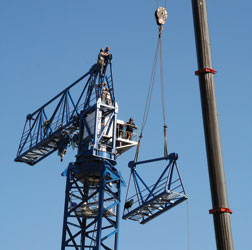The U.S. Occupational Safety and Health Administration will be taking a harder look at crane safety on jobsites while it also seeks public comments, due Dec. 8, on a long-awaited proposal to update its 40-year-old crane and derrick rules. Industry observers say OSHA has moved too slowly in the wake of many serious crane accidents this year.
 Tudor Van Hampton /ENR OSHA also broadens inspections.
|
A crane and derricks advisory committee (CDAC) convened more than four years ago negotiated the draft regulation. Since then, OSHA has conducted cost analysis and preamble writing required by statute. Key requirements, published in the Federal Register on Oct. 9, include new safeguards for powerlines, ground conditions, erecting and dismantling, inspections, signaling qualifications and crane-operator certification.
Some crane experts believe the CDAC rules have grown too many whiskers since 2004. “CDAC already needs to be rewritten,” says Frank Bardonaro, president of Amquip, a Bensalem, Pa., rental company. “It has sat too long.” Yet he and others say they hope the rules will help standardize increasingly spotty state and local regulations. “That is going to be a real burden if things don’t change soon,” says Bill Davis, senior risk consultant for insurer Zurich Services Corp.
OSHA also is launching a national emphasis program on cranes, broadening spot checks this year beyond high-risk regions. The initiative will boost contractor outreach and inspector education, says OSHA chief Edwin G. Foulke Jr. But critics counter that such measures are too late. “OSHA’s negligent foot-dragging on this issue has cost many lives,” says Mark H. Ayers, president of the AFL-CIO’s Building & Construction Trades Dept.
Costs to implement the rule would be $123.2 million per year with a net annual payback of $283 million. Operator certification is the largest cost component, estimated at $37.3 million per year. About 165,000 companies, 96,000 cranes, 86,000 operators and 2.3 million employees would be affected. Roughly 70% of existing operators would need to be certified and 8% would need annual testing because of labor turnover, OSHA says. National testing requirements for crane operators would phase in four years after initial implementation.
Observers don’t expect enactment any time soon and say it could be many months before the rule becomes final.

Post a comment to this article
Report Abusive Comment